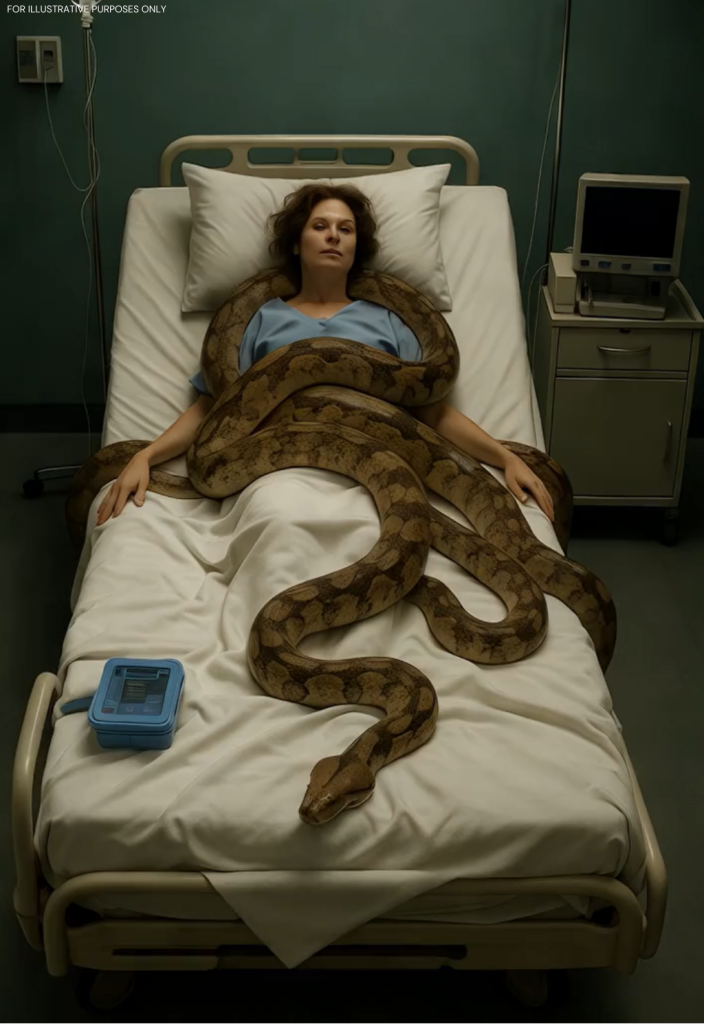Each time her parents visited, they voiced the same warning.

“Miranda, you need to be careful,” her father insisted. “That’s not a pet cat. It’s a predator.”
She would chuckle. “You’re exaggerating. He’s calm, he trusts me. Look — he never even hisses when I handle him. Ambrose cares for me.”
For nearly four years, things were fine. Then something shifted.
It began when Ambrose refused food. The frozen rabbits he once devoured in seconds were left untouched. Weeks passed. Miranda assumed it was just a seasonal slump and tried again, but the python turned away every time.
Soon, stranger habits appeared. At night, Ambrose would nudge the lid of his tank open and slither onto her bed. Instead of coiling in one spot, he stretched himself full-length beside her, his head near her shoulder, his tail grazing her ankles. Sometimes, he wrapped loosely around her waist and stayed utterly still. Miranda, half amused, whispered that he was hugging her.
By day, he sprawled across the cool tile in her bedroom, motionless except for the flicker of his tongue. His eyes always lingered on her chest rising and falling. She found it endearing, proof that he enjoyed her company.
But the moments became unsettling. More than once she woke to find her chest pinned beneath his weight, her breaths shallow under his coils. He pressed his head against her collarbone, tongue darting across her skin. She forced a laugh and called it a kiss, but unease crept in.
One night, a sharp hiss burst by her ear. Ambrose shifted heavily against her ribs. For the first time, fear truly gripped her.
The next morning she carried him to a reptile vet. The clinic smelled of cedar and disinfectant. Dr. Ellison, a silver-haired specialist, examined the python carefully, running practiced hands over the muscular body. Miranda described the fasting, the nightly stretching, the wrapping at her waist. She expected reassurance.
Instead, the doctor removed his glasses and spoke evenly.
“Miranda, that isn’t affection. Large constrictors sometimes starve themselves when preparing for bigger prey. Lining up beside you isn’t cuddling — it’s measuring. And coiling around your waist? That’s a practice run.”
Her stomach dropped. “You mean… he was preparing?”
“Yes,” Dr. Ellison said. “She’s a full-grown python, perfectly capable of killing and swallowing an adult. Refusing food means she’s leaving room for something larger. My recommendation: isolate her immediately and place her in a proper facility. This is dangerous.”
The words hit like ice water. On the drive home, Miranda replayed every memory of Ambrose “hugging” her, now darkened with new meaning.
That evening, she sat on her bed while the python slid silently across the sheets. Once again, he curled around her waist, just as before. But this time, Miranda recognized the intent. Carefully, she lifted him, avoiding sudden movements, and returned him to the terrarium. When the latch clicked shut, she sat on the floor, staring as Ambrose pressed his head against the glass.
At dawn, she called the local reptile rescue. By afternoon, professionals arrived, calm and efficient, transferring the python into a secure crate. They explained he’d live in a spacious sanctuary, properly fed and monitored.
From her porch, Miranda watched the truck drive away. Her home felt emptier, but for the first time in weeks she breathed easily. No weight on her chest. No silent predator sizing her up in the dark.